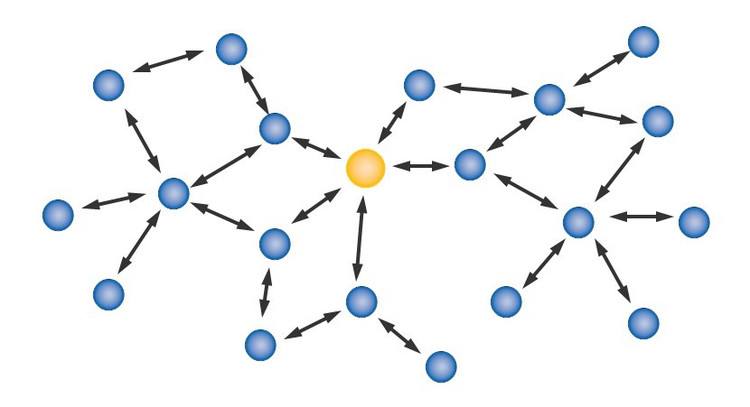Intelligent Encyclopedia | What is a quantum network?

Intelligent Encyclopedia | What is a quantum network?

Quantum networks are the foundation for future high-speed enterprise communications.
The technologies required for seamless quantum networks must be deployed on multiple nodes over long distances to enable ultra-secure, reliable and fast qubit data transmission. The principles of quantum physics are the basis of quantum networks.

What is a quantum network?
Quantum networks are directly related to quantum physics and communications. Its physical infrastructure consists of multiple quantum processors that exchange information in the form of qubits. Quantum networking is the process of transmitting and receiving information encoded in qubit states within a quantum network.
The principles of quantum physics govern quantum network protocols and algorithms that exchange information in a highly encrypted manner between multiple nodes distributed over large distances. These principles enable quantum network protocols to provide fast, reliable and secure communications.
Because quantum networking is a completely new networking technology, it can be a challenge for providers to commercialize it. This article discusses some of the advantages and disadvantages of quantum networks, as well as the challenges associated with their implementation.
Benefits of Quantum Networks
Although quantum networks are still in their infancy, they have great potential to provide a variety of next-generation advantages. Benefits of quantum networks include:
- Wide range of applications
- solve problems together
- long distance communication
- reliable transmission
- Enhance security
- Quantum cryptography
- Error detection and correction
Applications are widespread
in quantum networks, where information is sent and received in the form of quantum bits (often called logical qubits). The entangled, or superposition, state of qubits encodes information. These qubits exist in multiple states simultaneously, namely 0, 1, or both, but change when measured due to the collapse of the wave function.
Photon energy drives most quantum networking technologies. The two-particle and wave-like properties provide various quantum-related applications such as quantum sensing, quantum teleportation, quantum simulation, etc.
Solving problems together
Ideally, a certain number of quantum networks could deploy multiple nodes to solve common problems. Quantum networks require high computing power and speed to compute complex problems.
For example, distributed quantum computing is a cluster of quantum networks in which multiple quantum processors are connected to work together to solve complex problems and perform high-speed calculations. Quantum network infrastructure can also be connected to the quantum Internet, forming a quantum Internet of Things with quantum processors, sensors, repeaters, controllers and other devices.
Telecommunications
Quantum entanglement describes the transmission of qubits over long distances. In a quantum network, two or more qubits are in an entangled state with the same or opposite spin. These qubits are first intertwined and then separated by large distances.
If the state of one qubit changes while being measured, the other qubit automatically changes. Quantum entanglement is sometimes called quantum teleportation because the actual qubits are not transmitted through the channel to routers and other network devices.
The transport-reliable
TCP/IP model describes the transmission of data packets over the network and their acknowledgment by the recipient. Quantum networks eliminate the need for confirmation because the state of the interweaving can be predicted.
Quantum repeaters are deployed in single or multiple locations to enhance the reliability, computing power and range of quantum networks. In other words, quantum repeaters reduce the effects of decoherence and signal loss to provide accurate information.
Enhanced security
The non-cloning theorem states that it is impossible to copy quantum information from an unknown state to another state. Hackers known as eavesdroppers are unable to create completely independent and identical copies of unknown entangled quantum states.
However, hackers can try to manipulate the qubits in a quantum network to achieve a certain degree of replication. Quantum network protocols can detect manipulation on the channel and provide quantum error detection and correction to ensure a high level of security.
Quantum Cryptography
Quantum networks incorporate quantum cryptography to encrypt and decrypt information. Quantum Key Distribution (QKD) is a quantum encryption protocol that shares keys in the form of qubits or polarized photons over an insecure network.
In quantum cryptography, Heisenberg's uncertainty principle states that it is impossible to simultaneously measure a particle's velocity and position to achieve an ultra-secure connection. The sender and receiver compare measurements to eliminate errors, detect third-party attempts, and decrypt keys. QKD protocols include BB84, decoy-based QKD, etc.
Error Detection and Correction
Quantum networks can help achieve high accuracy through quantum error detection and correction algorithms. Many error correction algorithms detect deviations in the received qubit state from the transmitted photon.
These protocols enable users to identify possible hacking attempts on quantum networks. Some error correcting codes include short-range codes, Bose codes, and bit-flip codes.
Quantum Network Challenges
While quantum networks have many benefits, they are not without challenges. Disadvantages of quantum networks include:
- The fragility of quantum information
- complex manipulation
- Slow communication
- Scalability issues
- high cost
- complex integration
Fragility of Quantum Information
Quantum information is inherently fragile, which makes it susceptible to environmental factors such as quantum interference, decoherence and signal loss. Network professionals can deploy quantum repeaters across multiple network segments to maintain the accuracy of quantum networks. Additionally, quantum operators need to operate on qubits during error correction.
Complex manipulation
From an enterprise perspective, the inability to replicate quantum states could limit many conventional applications. In these cases, quantum logic gates manipulate quantum information between nodes to enable transmission. However, quantum logic gates cannot violate the no-cloning theorem.
Communication is slow
A common misconception is that quantum communication is faster than the speed of light. However, quantum networks often use traditional communication methods to eliminate the possibility of faster-than-light communication. Quantum networks use fiber optics to communicate, just like the traditional Internet.
Scalability Issues
Long-distance quantum communication is currently hypothetical because quantum networks with many nodes use short distances to separate them. Quantum networks typically have fewer processors than classical networks. Quantum processors can actually generate fewer superposed or entangled qubits in quantum network protocols.
High Cost
Quantum networks require high investment costs to implement and maintain. Quantum network hardware and software require significant investments in technology, engineering and cost. High-budget industries, such as government, deep space research, and cryptography projects, are better suited for quantum networks.
Complex integrated
quantum networks have their own standardization and interoperability required for hybrid networks. In order to merge with the classical Internet, the network must deploy a large number of quantum processors. Furthermore, the TCP/IP communication model and quantum networks work on different technologies, making it difficult to combine them.
The future of quantum networks
Large businesses and organizations are interested in quantum networks to enable optimized computing and rapid communication and to solve complex problems.
It will take years for quantum networks to be as affordable and commercially viable as current computer networks. Over the next few decades, industries as diverse as IT, space, research, healthcare, and retail could enable fast communications and high-performance computing through quantum networks.